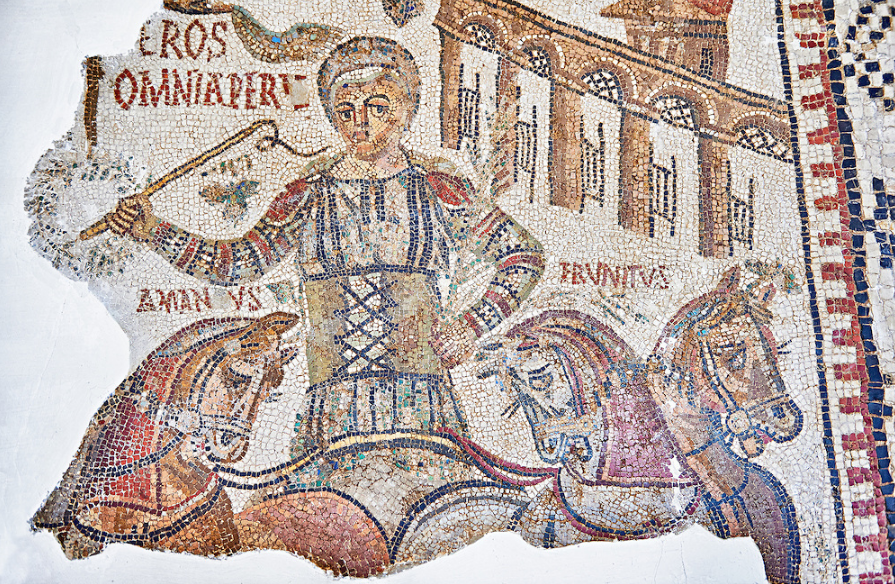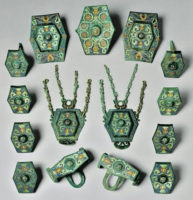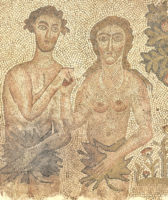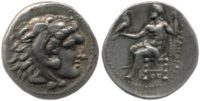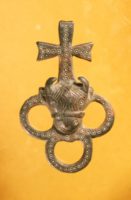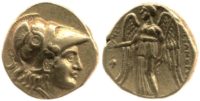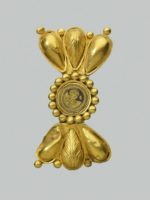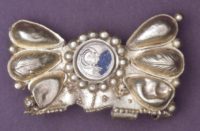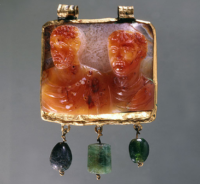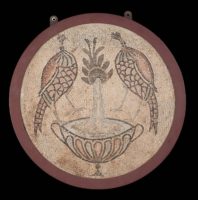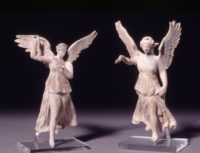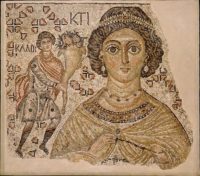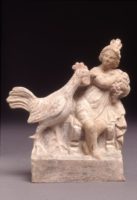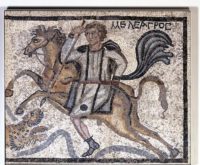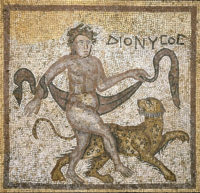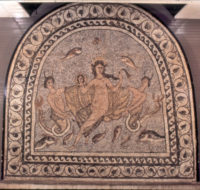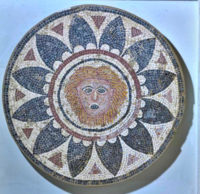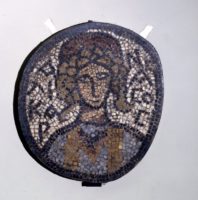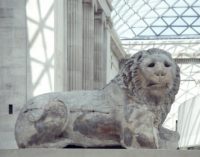4th century Roman mosaic panel of Eros, a circus chariot rider of the Red Fraction. From Tunisia. The Bardo Museum, Tunis, Tunisia.
Siege of Constantinople in 1453 (fresco), Romanian School, (16th century) – Church of St George, Voronet Monastery, Bukovina, Romania.
Harness Ornaments. Period: Late Roman; circa: 200–400. Geography: Made in Thrace (possibly). The Metropolitan Museum of Art (New York) is one of the world’s largest and finest art museums. Its collection includes more than two million works of art spanning five thousand years of world culture, from prehistory to the present and from every part of the globe. Public Hours: 10:30 a.m.–5:30 p.m. Open seven days a week.
Fragment of a Floor Mosaic- Adam and Eve, Period: late 400s-early 500s, Early Byzantium, Northern Syria. The Cleveland Art Museum Hours: Tuesdays, Thursdays, Saturdays, Sundays 10:00 a.m.–5:00 p.m. Wednesdays, Fridays 10:00 a.m.–9:00 p.m. Closed Mondays.
Silver coin of Alexander the Great; Greek; Date: 323BC-280BC; Kingdom of Macedonia, Minted in: Anatolia, Turkey (Uncertain mint, Western Asia Minor) Weight: 4.12 grammes. Die-axis: 12 o’clock. British Museum is closed 24, 25 and 26 December and 1 January, but is open every other day of the year. Fast facts about the British Museum: Founded: 1753, Collection size: 8 million objects, Oldest object in the collection: Stone chopping tool (nearly 2 million years old).
Silver Coin of Alexander the Great. Head of young Herakles, right, in lion scalp. (reverse) Zeus seated, left, holding eagle and sceptre. Date: 323BC-280BC (circa). Minted in: Anatolia, Modern Turkey (Uncertain Mint, Western Asia Minor) British Museum is closed 24, 25 and 26 December and 1 January, but is open every other day of the year. Fast facts about the British Museum: Founded: 1753, Collection size: 8 million objects, Oldest object in the collection: Stone chopping tool (nearly 2 million years old).
Harness; Carriage Fitting; Period: Late Roman; 4th. c.; Found: Anatolia, Turkey. British Museum is closed 24, 25 and 26 December and 1 January, but is open every other day of the year. Fast facts about the British Museum: Founded: 1753, Collection size: 8 million objects, Oldest object in the collection: Stone chopping tool (nearly 2 million years old).
Gold Coin of Alexander the Great (obverse) Head of young Herakles, right, in lion scalp. Date: 323BC-280BC (circa). (reverse) Zeus seated, left, holding eagle and sceptre. Minted in: Anatolia, Modern Turkey. British Museum is closed 24, 25 and 26 December and 1 January, but is open every other day of the year. Fast facts about the British Museum: Founded: 1753, Collection size: 8 million objects, Oldest object in the collection: Stone chopping tool (nearly 2 million years old).
[xyz-ihs snippet="British-Museum"]Three Fragments of a Buckle or Brooch. Material: Gold. Period: Late Roman. Found/Acquired: Anatolia, Turkey (?) British Museum is closed 24, 25 and 26 December and 1 January, but is open every other day of the year. Fast facts about the British Museum: Founded: 1753, Collection size: 8 million objects, Oldest object in the collection: Stone chopping tool (nearly 2 million years old).
Plate of a buckle or brooch; gold; Period: 4th c., Late Roman/Early Byzantine. 3 hefty studs at the back, as well as tubes for a joint at one side. In the centrea a little nielloed medallion with a hefty pearled border consisting of the bust of a beardless nimbed emperor wearing a chlamys with big fibula. Over and also below are 3 almond-shaped lobes, each center one embossed to simulate a leaf. Found Place: Anatolia, Turkey (?)
British Museum is closed 24, 25 and 26 December and 1 January, but is open every other day of the year. Fast facts about the British Museum: Founded: 1753, Collection size: 8 million objects, Oldest object in the collection: Stone chopping tool (nearly 2 million years old).
Busts of Two Emperors, Period: Roman, Circa: Late 3rd-early 4th century, Material: Chalcedony on gold. The museum is open to the public Tuesday through Sunday, 11:30 a.m.–5:30 p.m., except for federal holidays.
Mosaic, Two Peacocks Perch on a Fountain, Period: Early Byzantine, circa: A.D. 450–462. The MFA is open 7 days a week. Monday and Tuesday 10 am–5 pm, Wednesday–Friday 10 am–10 pm, Saturday and Sunday 10 am–5 pm.
Terracotta Figure of Winged Nike Flying, wings raised, Period: Hellenistic 1stc(late) BC-1stc(early) (circa) Acquisition Date: 1893. Her left leg outstretched (perhaps coming down to land), her right hand raised and holding a small wreath, her left hand pulling at the drapery on her left thigh, wearing peplos belted high up under the breasts leaving her left bare, her left leg emerging from the garment at thigh level, wavy centrally parted hair drawn back into. Made in: Myrina, Anatolia (Modern Turkey) British Museum is closed 24, 25 and 26 December and 1 January, but is open every other day of the year.
Fragment of a Floor Mosaic with a Personification of Ktisis, Period: Early Byzantine circa: 500–550, with modern restoration. Materials: Marble and glass. The Metropolitan Museum of Art (New York) is one of the world’s largest and finest art museums. Its collection includes more than two million works of art spanning five thousand years of world culture, from prehistory to the present and from every part of the globe. Public Hours: 10:30 a.m.–5:30 p.m. Open seven days a week.
Terracotta figure of a boy with a cock, Period: Hellenistic, 1th c. BC. (circa) Material: Terracotta. Boy sprawling back across a low bench with finely modelled legs, leaning to the viewer’s right, both hands holding a big bunch of grapes out of the way of a very large predatory cock approaching from the left. Excavated: Myrina Ancient City, Anatolia. (Modern Turkey, Aliaga, Izmir) Acquisition date: 1891. British Museum is closed 24, 25 and 26 December and 1 January, but is open every other day of the year. Fast facts about the British Museum: Founded: 1753, Collection size: 8 million objects, Oldest object in the collection: Stone chopping tool (nearly 2 million years old).
Mosaic Pavement; Period: Late Roman; circa: 4th c.; Excavated/Place: Halicarnassus, Modern Turkey, Aegean Region, Anatolia. Materials: stone. Dimensions: Height: 1.4 metres Length: 1.67 metres. Museum Description: Part of a panel from a mosaic pavement: Meleager, on horseback, spears a leopard. The panel is inscribed in Greek with the hero’s name.
British Museum is closed 24, 25 and 26 December and 1 January, but is open every other day of the year. Fast facts about the British Museum: Founded: 1753, Collection size: 8 million objects, Oldest object in the collection: Stone chopping tool (nearly 2 million years old).
Mosaic Pavement; Period: Late Roman; circa: 4th c.; Excavated/Place: Halicarnassus, Modern Turkey, Aegean Region, Anatolia. Materials: stone. Dimensions: Height: 1.4 metres Width: 1.36 metres. Museum Description: Panel from a mosaic pavement, Dionysos dances to the right, with the panther running behind and looking up at him. Dionysos wears a grey-green wreath, and carries a strip of red drapery edged with black. The name of Dionysos is inscribed in Greek.
British Museum is closed 24, 25 and 26 December and 1 January, but is open every other day of the year. Fast facts about the British Museum: Founded: 1753, Collection size: 8 million objects, Oldest object in the collection: Stone chopping tool (nearly 2 million years old).
Mosaic of Venus and Tritons, Period: Late Roman; circa: 4th c.; Materials: stone. Dimensions: Height: 1.96 metres Width: 2.11 metres (at base) Excavated/Place: Caria, Bodrum, Hadji Captan’s Field (Halicarnassus). Excavated by: Sir Charles Thomas Newton, 1857. Museum Description: Venus is seated on a twisted shell, which is seen to the right; In her right hand she holds a circular mirror which reflects her full face; in her left hand she holds a long tress of hair; behind her is a veil held by a Triton on either side; the Tritons have curling forked tails and a pair of claws on their heads; below are two dolphins, one crab, and three. British Museum is closed 24, 25 and 26 December and 1 January, but is open every other day of the year. Fast facts about the British Museum: Founded: 1753, Collection size: 8 million objects, Oldest object in the collection: Stone chopping tool (nearly 2 million years old).
Roman Mosaic, Period: Late Roman; circa: 4th c.; Excavated/Place: Caria, Bodrum, Hadji Captan’s Field (Halicarnassus), Anatolia. Materials: stone. Dimensions: Diameter: 105.41 centimetres. Museum Description: Stone mosaic; medallion with mask of Phobos in the centre of rosette with 12 petals; triangles between rosette petals; the mask is red-brown and ochre; rosette petals are black and the triangles are red-brown. British Museum is closed 24, 25 and 26 December and 1 January, but is open every other day of the year. Fast facts about the British Museum: Founded: 1753, Collection size: 8 million objects, Oldest object in the collection: Stone chopping tool (nearly 2 million years old).
Circular mosaic. Personification of the city of Halicarnassus. Period: Late Roman; circa: 4th c.; Excavated/Place: Halicarnassus, Modern Turkey, Aegean Region, Anatolia. Materials: stone. Dimensions: Height: 54.5 centimetres Width: 49.5 centimetres. British Museum is closed 24, 25 and 26 December and 1 January, but is open every other day of the year. Fast facts about the British Museum: Founded: 1753, Collection size: 8 million objects, Oldest object in the collection: Stone chopping tool (nearly 2 million years old).
The Lion of Knidos, Museum Description: Colossal marble statue of a recumbent lion; carved with inlaid eyes originally probably of glass, but now missing. Period: Hellenistic, circa: 2nd century BC. Excavated/Findspot: Knidos, Lion Tomb (Turkey, Aegean Region, Caria, Knidos Ancient City, Anatolia). Materials: marble, glass (eyes). Technique: inlaid (eyes) carved. Dimensions: Length: 2.89 metres Height: 1.82 metres. Location: Not on display (Great Court) Acquisition date: 1859, Discovered by Richard Pullan during Charles Newton’s excavations in 1858; removed by Robert Murdoch Smith; brought back on HMS Supply. British Museum is closed 24, 25 and 26 December and 1 January, but is open every other day of the year. Fast facts about the British Museum: Founded: 1753, Collection size: 8 million objects, Oldest object in the collection: Stone chopping tool (nearly 2 million years old).
[xyz-ihs snippet="British-Museum"]

